It’s been quite a busy month wine-wise. I am in the middle of a number of articles, including my trip to France, which was a lot of fun with some truly excellent wines. At the same time, it has been very busy professionally and personally and so I am VERY behind on my writing. Luckily, I did have the time to squeeze in an RCC this month, and I hate holding off on those notes – so here we are. This month’s RCC, hosted by Simon Jacob, was really special. First, we had a visit from Yossie Horwitz of Yossie’s Corkboard. Besides being an excellent lawyer and one of the most knowledgeable people in the kosher wine world, his real claim to fame in this context is that he is the creator of the RCC concept! So if you are one of the hundreds of people who gets together each month to celebrate Rosh Chodesh over a festive dinner and some excellent wine, join me in raising a glass to Yossie! The concept has gotten so popular that even Herzog has borrowed it and is using it to sell monthly wine dinners at Tiera Sur (of course, it really isn’t the same – the whole point is for people to get to gather and share bottles that they have been saving, rather than having a winery determine which wines you will be drinking, but still I guess imitation is the sincerest form of flattery). In addition to having Yossie with us, which was truly a surprise based on the current Omicron closure situation, we also were lucky enough to have one of the originating RCC-Israel chefs, Bracha Arnold, come and cook for us. While I do love many of the chefs and restaurants that take care of us for RCC, Bracha’s dishes are always something special. There is always something inventive and unique – while being absolutely delicious. This month’s highlights for me were the mackerel sashimi over this wonderful kiwi gazpacho, as well as, surprisingly, the vegetarian dish, which was carrot mochi with pickled carrots and pistachio dukkah. If I had to describe what mochi are I would say rice flower gnocchi but with a fair amount of chew – really special. My favorite dish though was likely the desert, which this truly delicious salted honey pie with blueberry ginger lime sauce – absolutely outstanding. But as always, this blog is about the wine, so here it goes…..
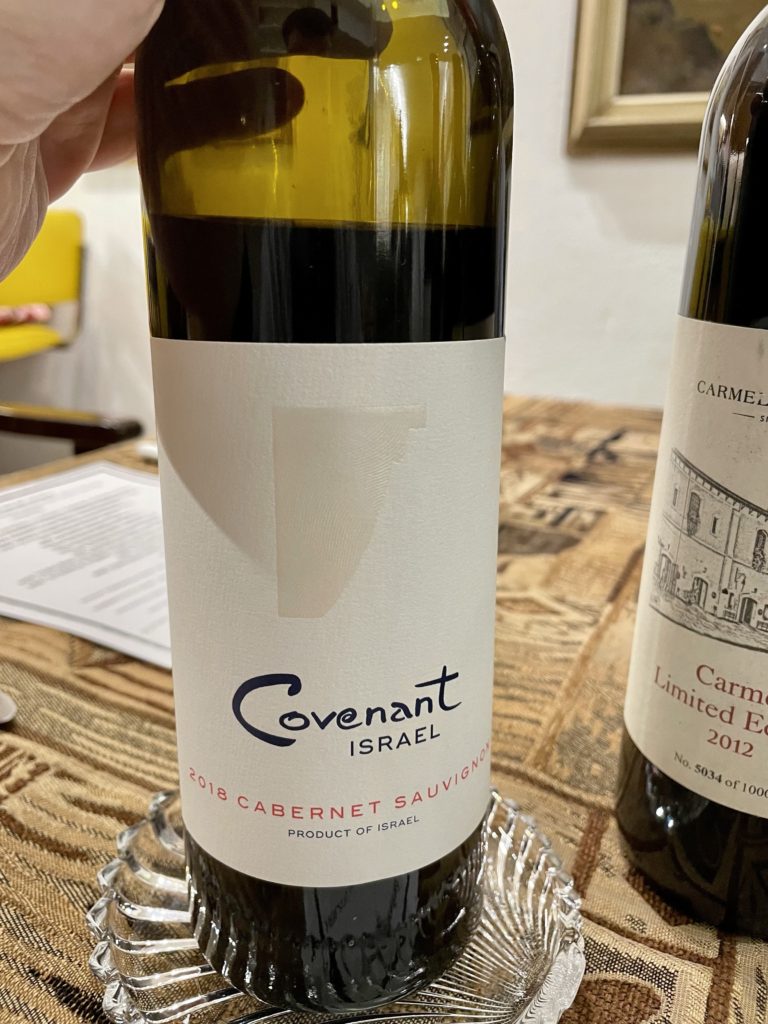
Covenant Israel, Cabernet Sauvignon, 2018 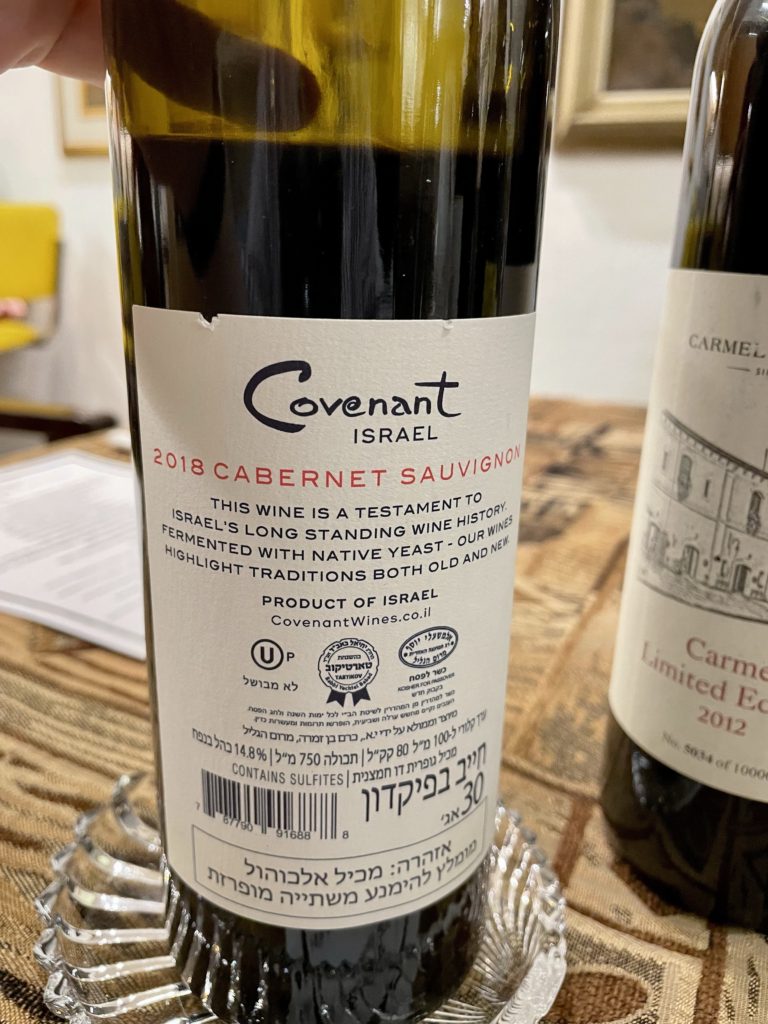
Covenant Israel, Cabernet Sauvignon, 2018 (Pregame Bonus Bottle) – I got to Simon early to help set up, and he decided to pregame with a bottle that neither of us had tasted as of yet due to the pandemic – the Covenant Israel Cabernet Sauvignon. I have to say, I was surprised at this release. When Covenant first launched their Israel operation, they stayed away from releasing wine varietals that they were releasing in California. I remember Jeff Morgan speaking about the appropriate grapes to grow in Israel vs the US, etc. I guess there has been a change of heart. As we had plenty of time before people started showing up, I had the chance to write full notes rather than the standard RCC shorthand. On the nose, very dark fruit – plum, blackberries, some ripe blueberry, and then some spice. In the mouth, up front it very much duplicates the nose with blackberry, plum, and blueberry. It moves into some notes of anise, clove, sweet tobacco, and vanilla, with a bit of graphite. This was a lighter than one would expect, with a medium body, even though it comes in at 14.8% alcohol. There is medium acidity and some rough tannin that has to work its way through the wine. It should improve over the next 3-5 years and hold for a couple after that. I would be cautious here, as there is no real track record for this wine yet. Overall it’s a very nice new world CS. I gave it a 91+ on the 100 point scale. My problem is the price. NIS 280??? I mean that roughly translates to $90. As a consumer, there is ZERO justification for that price – especially as it is a first release with zero track record on long (or even medium) term aging. The 2018 vintage in Israel is excellent – and there are plenty of excellent wines out there. If you are looking at the premium level CS’s take a look at Flam which I think so far was the best of the bunch and at 2/3 the price – with a proven track record (well-kept 2010’s are drinking beautifully). In short, nice wine for a ridiculous price.
Herzog, Special Reserve, Méthode Champenoise, Russian River Valley, NV – Another wine that was a first for me – and as we were still waiting for all of the guests to arrive – again, here are fuller notes than I would normally take for an RCC. The mousse here is a little underwhelming. The bubbles are rather large and dissipate quickly. The nose is muted. At best you get some vague chardonnay-ish notes of apple and a bit of yeast. In the mouth, it is crisp – I think helped out by those rougher bubbles, rather than the flavors of the wine. But those bubbles to me ultimately prove to be a bit out of place and present more like the seltzer bubbles of my youth – as they also go flat rather quickly. The flavors here are VERY basic and one-note. It’s chardonnay. Straight up. There is quince and lemon and not much else. Will it develop? I am going to guess not at this stage. It’s an 88-89 wine – making it another overpriced entry here at $50 in the US. Not sure why anyone is trying to compete with GHW at this point. For me outside of a VERY small number of Champagnes – they are the only game in town. And – if you are talking about aging potential – to date, there is no other kosher sparkling wine that can touch them – including the French…..
Carmel, Riesling, Kayoumi Vineyard, 2014 – For every wine there is a season. For this one, it’s passed. Sad but true. It was one of the greats, but it has gone flat. I have had it four times over the last 12 months – each time the wine has gotten slightly worse – this was my last bottle. Is it bad? No, but it’s a ghost of what it was with all of the petrol and acidity having disappeared from the wine. Drink up.
Elvi Wines, InVita, 2013 – Dead as a doornail.
Vitkin, Riesling, 2019 (Bonus Bottle) – Simon, Yossie, and I happened to have had dinner last week and Simon had brought this bottle, which was corked. It spooked him out as he is holding a number of these and so, after the first two whites bombed, he brought this out to pair with the Mackerel and Kiwi dish. He had nothing to worry about, my notes on this bottle stand. Really nice. A step behind 2018 overall but this should develop nicely. (BTW we also had 2018 last week – which is entering a dumb phase right now and closing down – this happens sometimes. I don’t think it’s anything to worry about and I’m still betting on these going a few more years).
Golan Heights Winery, Yarden, Cabernet Sauvignon, 2000 – This wine was another that was simply dead. Just a hint of acid and a touch of fruit that basically died within 15 minutes.
Golan Heights Winery, Yarden, Cabernet Sauvignon, 2001 – As opposed to the 2000 mentioned above, the 2001 was in much better shape. Both were stored well – so this just goes up to a difference in vintage quality and perhaps individual bottle variation, which at this stage in any wine is going to become more prevalent, as even the tiniest differences in cork or placement in even the winery’s cellar can have an impact at wines of this age. Having said that, the wine is still way over the hill. There is NOTHING to be gained by holding Israeli wines of this age. NONE of them are improving. At best, there are a couple that are still surviving – but virtually none are still at peak. So while this did round the bases in terms of having some tannin and acid and enough fruit to make it actually enjoyable, it did it in a wheelchair. Please drink up.
Domaine Du Castel, Petit Castel, 2004 – What you have is some acid, some tannin, and the rest tastes like liquid dust. The deadest of the wines we tasted tonight. See above for my comments about over-aging wines.
Golan Heights Winery, Yarden, Syrah, Bar’On Vineyard, 2014 – A little disappointed here – but not overwhelmingly so. Ultimately the 2013 Bar’On that we had at an RCC back in April was simply a much better bottle. This wine has always been more pushed and in the style of more recent GHW wines. For what it is, it’s fine and showed well, but I was hopeful that this vineyard would prove to be an outlier in the way GHW produced wines – and that is simply not the case, with 2013 being the exception that proves the rule. Overall though, the wine is very nice for what it is and is in a good place now. But it is VERY ripe with sweet blackberry and blueberry and a bit of blackcurrant. There is some good spice and a healthy hit of sweet herbs. Yes, the wine is on the sweeter side, but it is well made and not really date-like at all, just not anything exceptional.
Elvi Wines, Herenza, Reserva, Rioja, 2010 – This wine is likely at peak now. There are no real changes from any tastings over the last couple of years – and no real development either. It does drink very well though and is still one of my favorites. It’s also pop and pour with no decanting needed. I would say drink now and over the next 2-3 years. I likely wouldn’t go past there with this vintage. (The 2009 on the other hand, if you are lucky to still be holding still has some time.)
Carmel, Limited Edition, 2011 – At this point, we moved on to tasting the three Carmel Limited Editions. As readers of this blog know, I have been a big fan of the Carmel LE. I think that historically it is a rather underappreciated wine. The wines from its inaugural vintage in 2003 through 2010, with one notable exception (2009), have all been excellent IMHO. So this was part of the evening that I was really looking forward to. Overall, while still very good, I think there is a bit of a drop quality-wise with 2011 compared with the 2010. Don’t get me wrong. It is still very well made. But for what was a rather cold year in Israel, I really didn’t expect something so ripe. Overall, it was really nice with red and black fruit and toasted herb on the nose. In the mouth we have ripe raspberry, blackberry, and plum, followed by sweet basil, some thyme, and sage. The finish is a mix of blackberry and tobacco. Like I said – it’s really very nice – I just expected something a little less ripe based on the year and how previous vintages have turned out.
Carmel, Limited Edition, 2012 – This bottle caused a bit of dispute. On the nose, I did not detect any sort of flaw and it actually smelled very nice. In the mouth there was a taste of TCA that seemed to come and go. Some people blamed their glasses (we pulled out some extra glasses to do the 3 LE’s side by side) – but these glasses were stored upside down and were dust free. Ultimately, In any event, I am sensitive to cork taint, so this bottle was out for me. I will say that outside of the cork, the wine did seem balanced and perhaps is excellent. Leaving this as an open question until next time.
Carmel, Limited Edition, 2013 – This wine felt hot to me – both on the nose and in the mouth. It threw off the balance of the wine for me. I really didn’t care for it and didn’t pay much attention past that. I’ll try again on the off chance that this was a bad bottle.
Elvi Wines, Clos Mesorah, 2013 – This was my favorite wine of the night. An absolute blockbuster. The last time I tasted this wine was nearly three years ago when we did a vertical Clos Mesorah tasting. At the time I wrote that the 2013 was the best vintage of this wine. That is no longer true. The 2017 is actually a better wine – but the 2013 is a close second. Currently, on the nose, we have some smoke and earth and very dark fruit. In the mouth, we have a beautifully constructed wine that is mineral driven with great earthiness, more dark red – near black fruit. The finish just goes on and on with earthiness, chocolate mushroom, and some lead pencil, with of course a hint of smoke. It is drinking beautifully now and may yet improve for another year or so and will hold for three or four years after that. Really, this bottle is a work of art (and I’m not just talking about the awesome label)!
Four Gates, Merlot, 2011 – I get to taste fewer Four Gates wines here in Israel than I’d like. As such, this is my first time drinking this wine. It was a bottle that was a bit controversial. Some thought that the wine tasted almost like a typical ripe GHW wine. I strongly disagreed. While the wine was ripe, heavy, and darker than I would have expected, it did have incredible balancing acidity that really pulled it together. Having said that, as I mentioned above, it did not present as other Four Gates bottles have in the past. It could be this bottle was shocked as it was on a plane only a few days before – or it could be just a phase or bottle variation. In any event I have two bottles of this vintage at home and will perhaps pop one at the next RCC to see where things are at.
Domaine Roses Camille, Echo de Roses Camille, Pomerol, 2014 – This is a wine that I have tasted a few times in the past couple of years. This was one of the better showings IMHO. As opposed to others at the table who thought this wine has another 15-20 years ahead of it, I happen to disagree. IMHO it is the ripest of the Echo’s released to date (and the least successful) – and has the shortest life ahead of it. That’s not to say it is bad in any way. It is SUPER enjoyable now. On the nose, some bright red fruit and nice toasted herb with some rich earth in the background. In the mouth, you have some beautifully structured wine, which unfolds in waves of tart red cranberries, raspberries, and some cherry, which is followed by nice rich earth and mushrooms. Ripe fruit is balanced out by some beautiful acidity, and the tannin here also shows a firm core. The finish is long and impressive with mushroom, earth, tobacco, and something almost creamy as the acid fades away. Really nice stuff. My guess is that it is still 1-2 years from peak and will hold for another 5-6 after that – but 15-20 years? I don’t think so.

Ya’acov Oryah, SMLH-V, 2020
Ya’acov Oryah, SMLH-V, 2020 – I have been meaning to write up this wine for nearly a year. For those that are familiar with Ya’acov’s famous Old Musketeer releases, this is a completely different animal. The SMLH stands for Skin Macerated Late Harvest – and the V for Viognier. And while there are many Skin Macerated wines around, and while Late Harvest wines are commonplace, as far as I can tell, this wine, being both SM and LH, is the first of its kind even in the non-kosher world. Its production is very similar to sweet German Rieslings where sulfur is added at a specific time during fermentation to abruptly stop it (the process is known as mutage). The difficulty here is that because the wine is sitting on its skins, it is impossible to know just how much or exactly when the sulfur has done its job, as there is always liquid that is hiding in the folds of the skins. This makes the addition of the sulfur much more of a gut feeling than the very carefully planned German Riesling, which is very formulaic. And so, you never know EXACTLY how the wine will turn out when you stop the fermentation. In this case, we have a wonderfully light lithe wine with beautiful floral notes that, while sweet, is not at all overpowering or cloying and has incredible bracing acidity to balance the wine out. The sugar content from the late harvest aspect of this wine already would let the wine age well, with the skin maceration adding even more protection and a touch of tannic bite. It really is an excellent wine and is worth seeking out if you can. As it is the first of its kind, I have absolutely no idea how this will age, but it has developed over the last year and actually gained a hint of heft. It will likely continue to develop nicely in the 7-10 years to come (though again, that’s just a pure guess).
My thanks again to Simon for hosting and Bracha for the truly excellent food. Chodesh Tov!
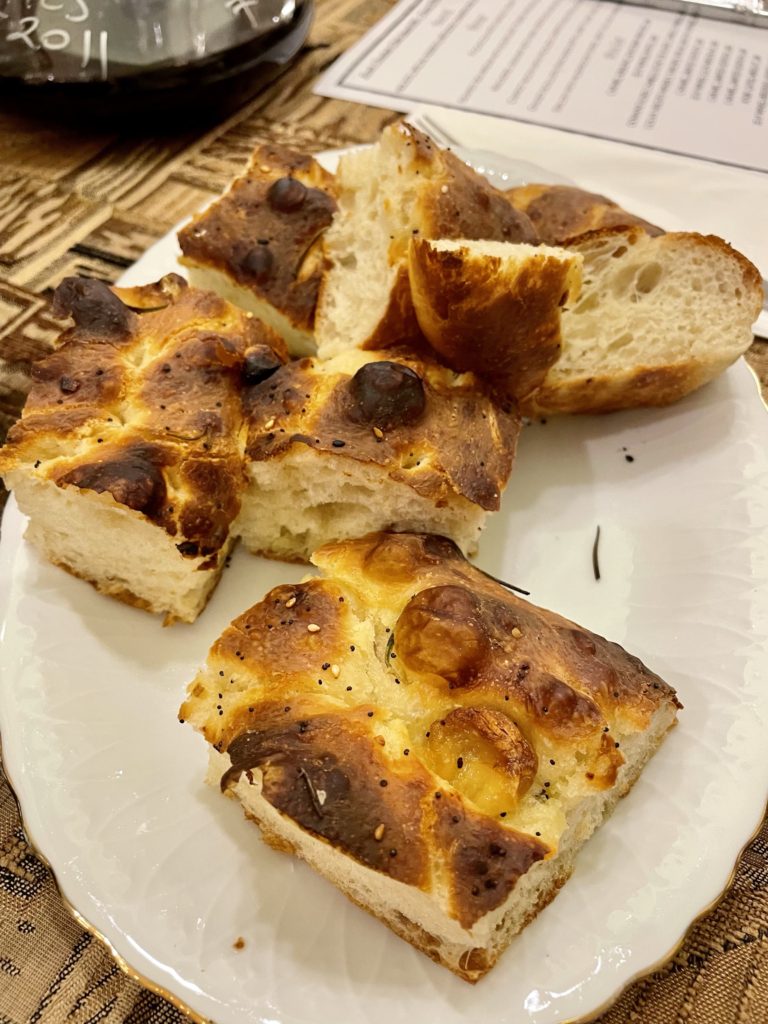
Focaccia with garlic confit 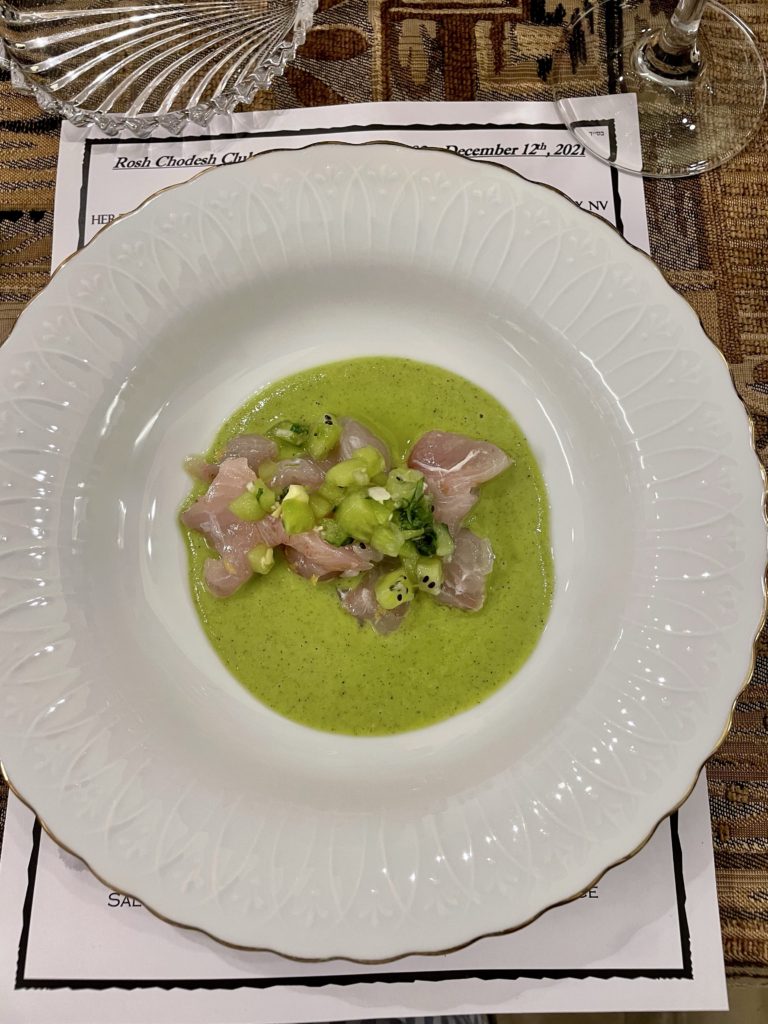
Mackerel sashimi with kiwi gazpacho and kiwi salsa 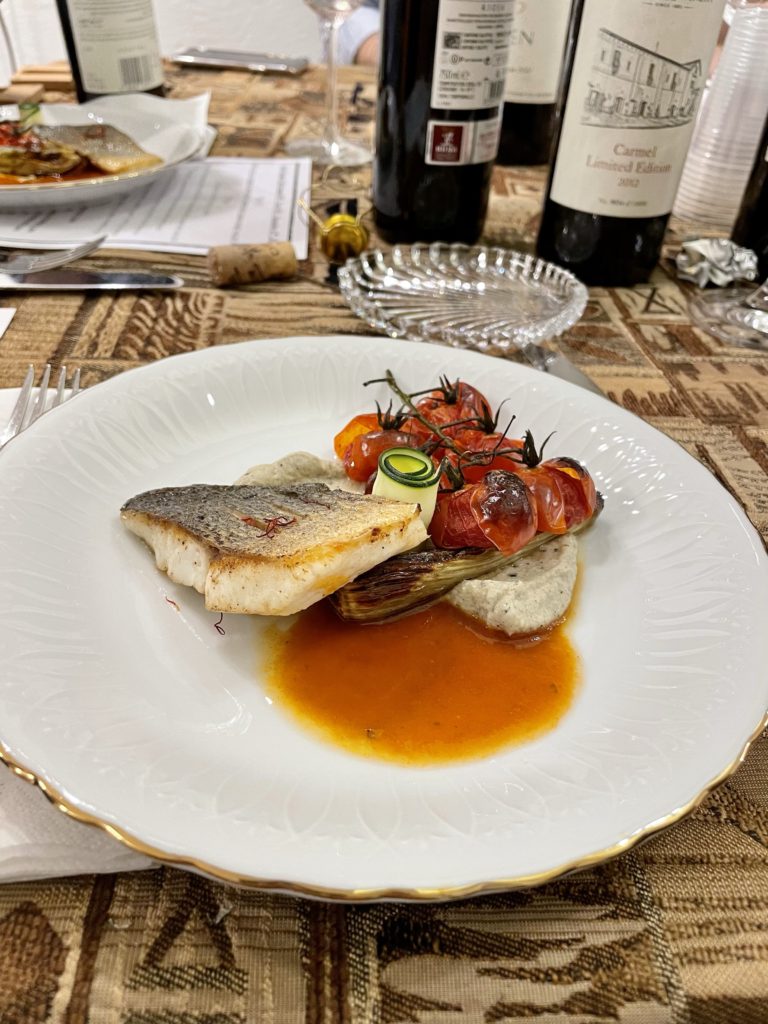
Seared sea bream with eggplant puree and bouillabaisse sauce 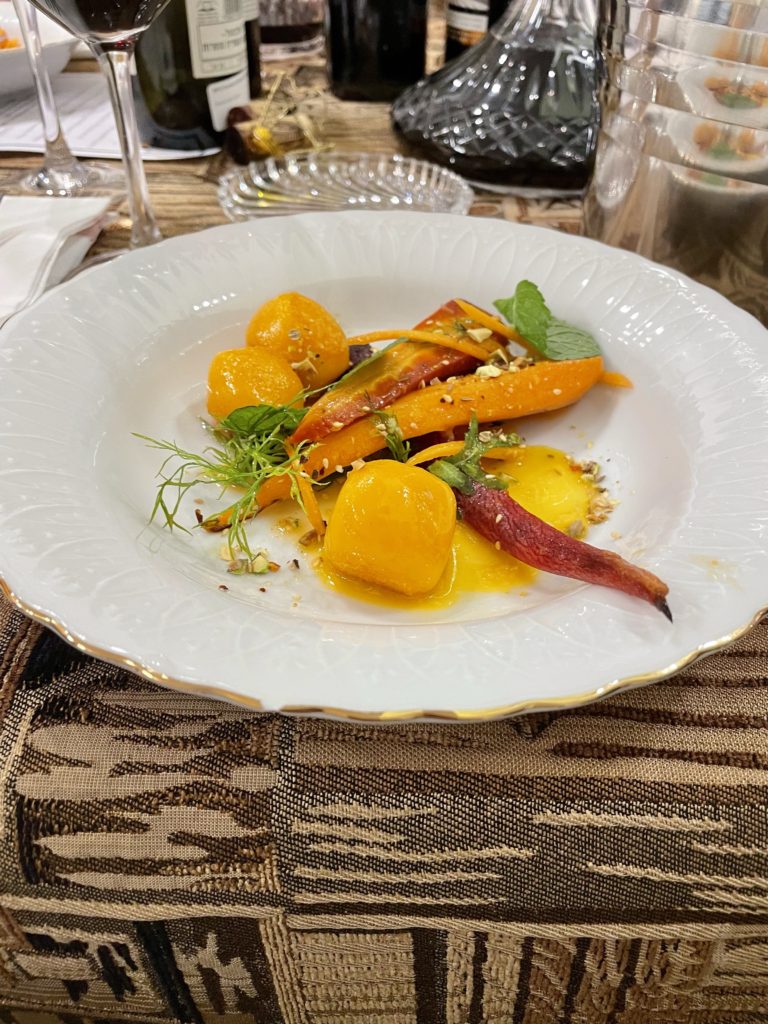
Carrot mochi with pickled carrots and pistachio dukkah 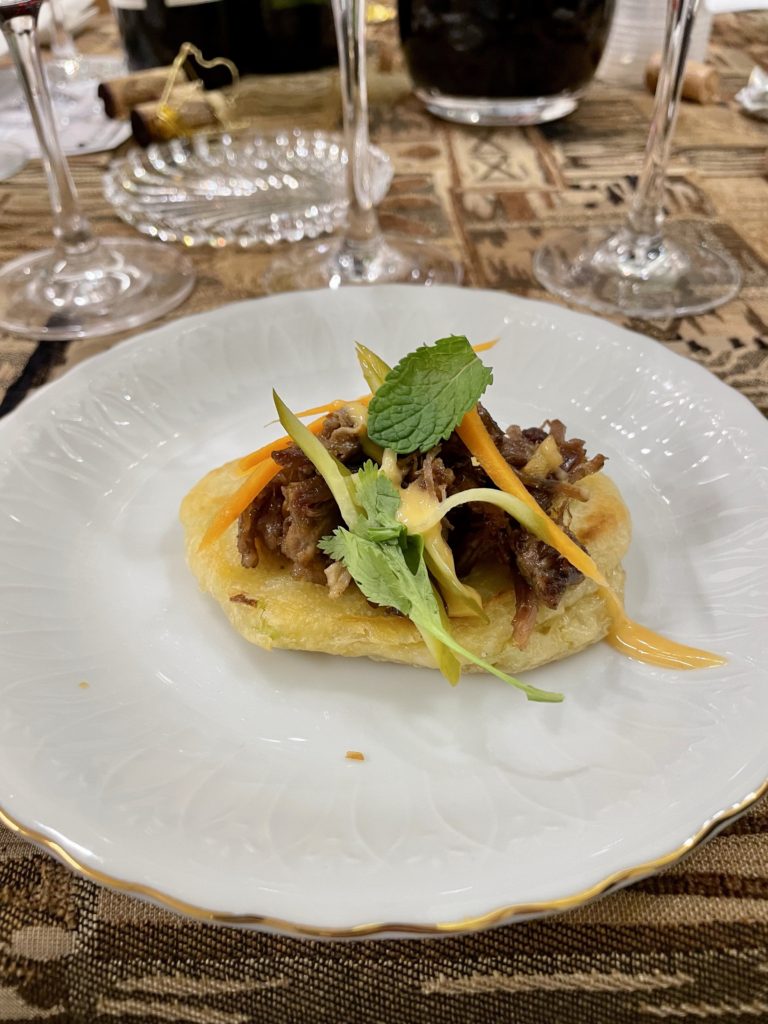
Ginger scallion pancakes with lamb “floss” and cucumber 
Sirloin with mushroom puree, beef jus, and pommes anna 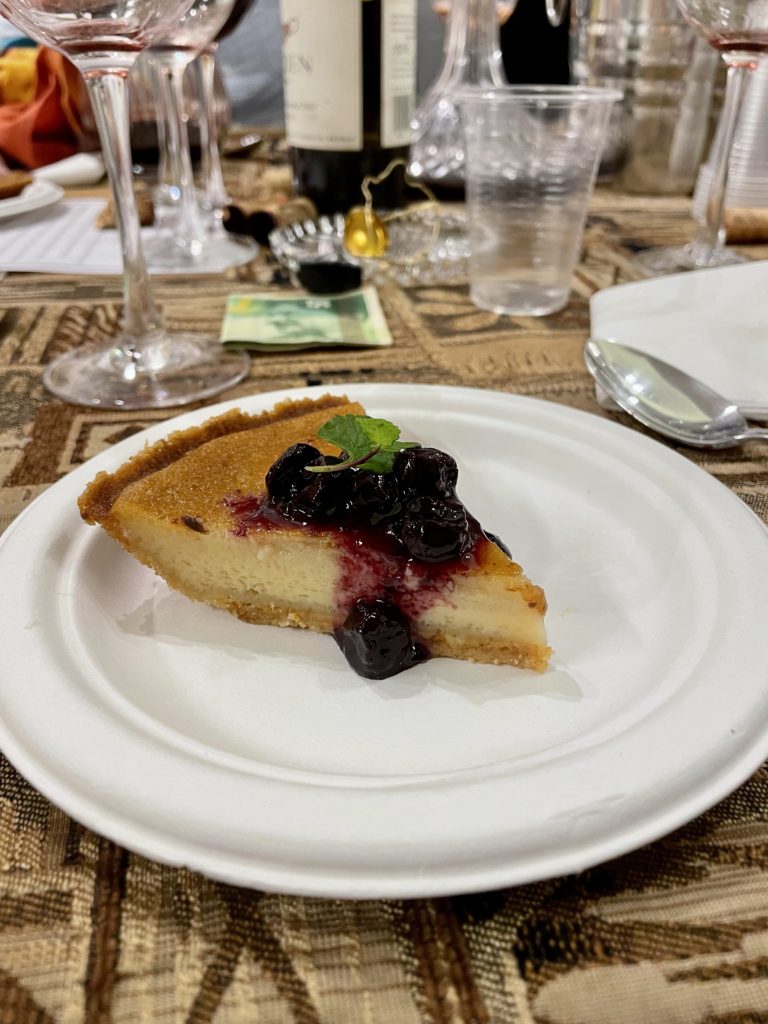
Salted honey pie with blueberry ginger lime sauce 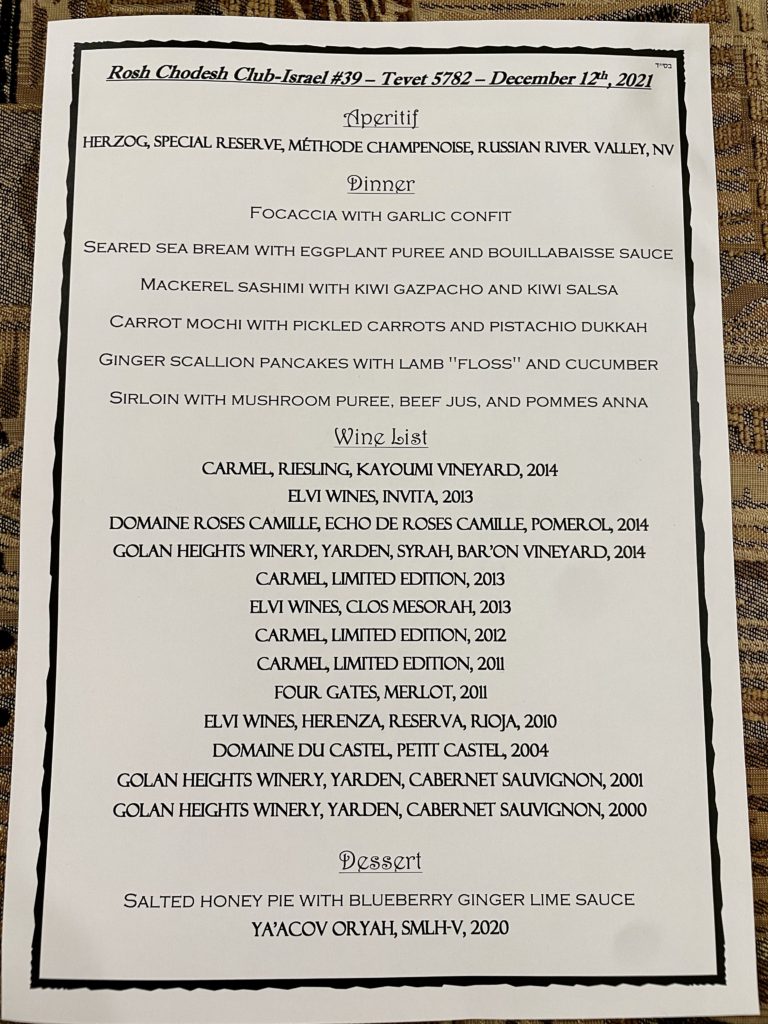
The menu & wine list 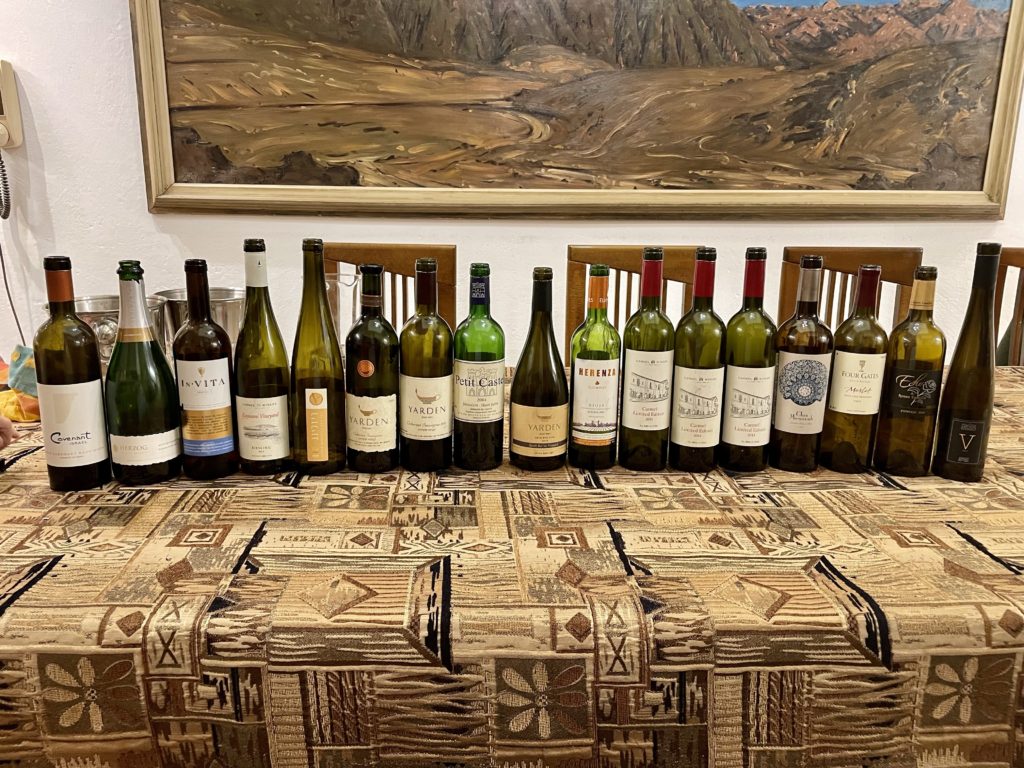
The lineup